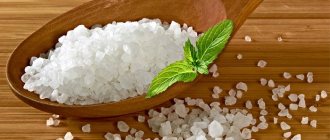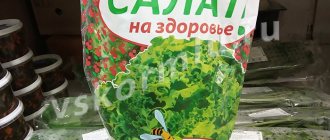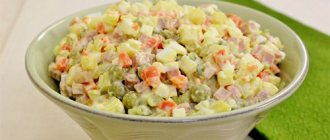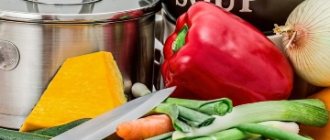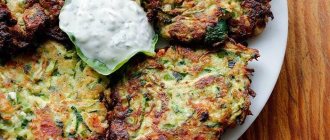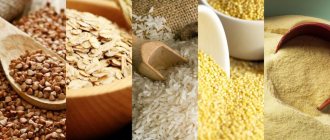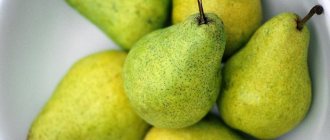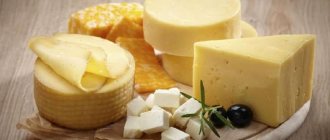Cucumbers are one of the most common and favorite vegetables. They are used in the preparation of salads, soups, and snacks. The vegetable is consumed fresh, salted, or pickled.
Many women included this product in their daily menu before giving birth. But during lactation you need to adhere to certain food restrictions so as not to harm the baby.
Therefore, it is worth figuring out whether cucumbers are useful for breastfeeding, when and how they can be introduced into your diet.
Useful properties and composition of cucumber
This vegetable contains a lot of valuable components:
- vitamins B1 (thiamine), B2 (riboflavin), B3, B9 (folic acid), A (beta-carotene), PP (niacin), C (ascorbic acid), E (tocopherol);
- macroelements (potassium, sodium, calcium, magnesium);
- trace elements (iron, cobalt, molybdenum, iodine, copper).
The huge proportion of fiber and low amount of calories make cucumbers simply irreplaceable in human nutrition. Their beneficial properties are:
- vegetable fiber helps prevent constipation, improves intestinal function, and cleanses it;
- thanks to the action of tartronic acid, carbohydrates are not converted into fat;
- protein absorption improves;
- potassium is necessary for the normal functioning of the heart muscle;
- have diuretic properties, cleanse the kidneys;
- are antioxidants, ensure the removal of toxins.
This is an incomplete list of the beneficial effects of cucumbers on the body. They are effective for weight loss after childbirth and are considered a dietary product. Can a nursing mother eat cucumbers? With a reasonable approach - yes.
Is it possible or not to eat cucumbers while breastfeeding?

This fruit is considered non-allergenic and is not on the list of non-recommended products. Cucumbers can be eaten while breastfeeding, but some factors need to be taken into account:
- individual characteristics of the body of a woman and baby;
- growing time (season);
- processing method (pickling, salting).
GW cucumbers are a permitted vegetable during the growing season (summer, early autumn). It is the fruits that grew in open ground that have lower pesticide content.
Expert opinion
Sokolova L. S.
Pediatrician of the highest category
Eating cucumbers grown in a greenhouse in winter and spring is not recommended for a nursing mother. Such vegetables contain a large amount of nitrates, which will negatively affect the condition of the mother and baby. They can provoke not only allergies, but also digestive disorders.
Effect on lactation
Consumption of this fruit does not have a significant effect on the lactation process and the volume of breast milk produced. The only thing you should pay attention to is that cucumbers have a diuretic effect, and milk production requires a lot of liquid. When including cucumbers in the menu, it is recommended to consume the required amount of fluid to ensure good lactation.
Effect on the baby
How to introduce cucumbers into the menu? This vegetable should be tried with caution, since the substances included in its composition can cause spasmodic muscle contractions, pain, and indigestion. When a child tolerates the appearance of cucumbers in his mother’s diet well, they benefit him. Fresh cucumbers during breastfeeding have a beneficial effect on the functioning of the heart and promote the mental development of the baby.
The benefits and harms of pickled cucumbers
The main product on a nursing mother's table should be vegetables, but they should be introduced into your menu with caution. The main product of a child's first year of life is breast milk, with which the body is saturated with vitamins. If the child does not have a reaction similar to rashes, redness, colic and bloating, it is necessary to eat vegetables.
Of course, the healthiest ones are fresh cucumbers collected from your garden in the summer. The composition includes a large amount of potassium, tartronic acid, coarse fiber, iodine, nicotinic acid, calcium, fluorine, iron.
The green vegetable has a beneficial effect on the heart muscle, kidneys, and normalizes the functioning of the stomach and intestines. By eating cucumbers, protein foods will be easier to digest, and excess water will leave the body. This is a natural diuretic. During breastfeeding, fresh cucumber juice acts as a laxative.
Any product consumed during lactation can bring benefits and harm. Among the consequences for the child are an allergic reaction in the form of a rash, individual intolerance to cucumber components, preservatives, and abdominal pain. By following the principles of proper nutrition, you can improve the health of the baby and mother. Low calorie content will not allow a young mother to gain excess weight.
Contraindications for mother:
- Stones in the kidneys, bile ducts.
- Inflammation of the genitourinary area.
- Enterocolitis.
- Hypertension.
- Gastritis.
- Ulcer, gastric erosion.
Before reaching 3-4 months, the baby suffers from colic and excessive gas formation. This forms enzymes, as well as the necessary microflora. Eating cucumbers, especially pickled and salted ones, enhances negative processes, so you should wait a bit with the introduction of pimpled vegetables.
We recommend reading: Ryazhenka during breastfeeding
Salted, pickled, fresh cucumbers for breastfeeding
Fresh cucumbers
From the very beginning of consumption, you need to eat fresh cucumbers in small portions, mainly in the morning. For the rest of the day, monitor the baby: if he feels excellent, then everything is in order; if anxiety or bloating is noticed, cucumbers are excluded from the mother’s diet. When can I try again? At least two weeks later, when the child’s digestive system gets stronger. Start again with a small piece. If there are no negative consequences, the portion can be increased and observation continued.
Salted cucumbers
Can I have pickled cucumbers? This type of product is not prohibited. They contain many useful components. But excess salt in the body can lead to fluid retention, which can cause swelling and poor condition of the mother. In addition, pickles can cause a feeling of thirst not only in a woman, but also in a baby: he will become restless, irritable, and demand the breast to satisfy his thirst. Instead of pickled cucumbers during breastfeeding, it is better to use lightly salted cucumbers.
Pickles
Pickled cucumbers are excluded from the mother’s menu in the first months of the baby’s life. This also applies to homemade preparations. The marinade contains vinegar and spices; it is better for the mother not to consume them until the newborn’s body is stronger. Industrially produced products are questionable: it is unknown what fruits were used, how much salt and vinegar they contain.
Dishes with salted and pickled cucumbers
Since it has already been found out that a nursing mother can eat pickled cucumbers, it is worth understanding that it is better to eat them as part of other dishes. So, you can cook with them:
- Fresh cabbage salad with the addition of salted and pickled cucumbers.
- Rassolnik.
- Potato stew with meat and pickles.
- As an addition to any side dish.
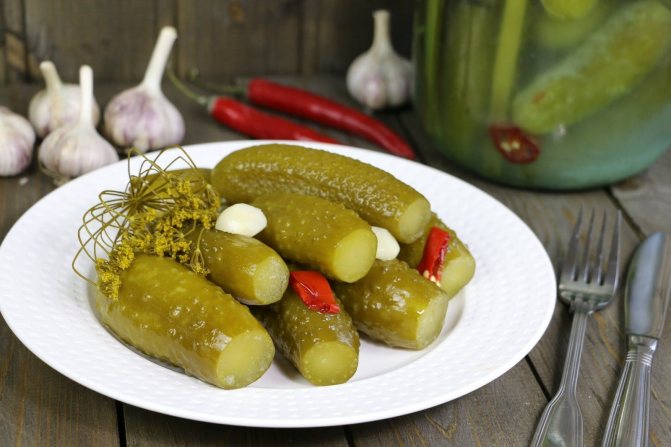
How to use it correctly during lactation

A woman should observe moderation in consuming all foods.
- Cucumbers are introduced into the diet gradually. After the first use, you need to monitor the reaction and well-being of the newborn.
- For a nursing woman, fresh cucumbers grown in open ground are suitable, i.e. summer and autumn.
- Pickles can be consumed in limited quantities. Choose those that are prepared at home (without the use of preservatives or flavor stabilizers).
- Do not eat this vegetable on an empty stomach.
How to correctly introduce cucumbers into the menu of a nursing mother?
The reaction of the female body to certain foods is passed on to the child. Therefore, introduce vegetables into your diet carefully. In medicine, there have been cases where babies developed various intestinal disorders after their mother ate fresh or lightly salted cucumbers. Basically they manifested themselves as:
- Painful bloating
- Formation of gases in the intestines
- The occurrence of colic
The most serious consequence that occurs in such situations is dysbiosis. Toddlers less than 3 months old are characterized by impaired intestinal function. Why is this happening? After eating cucumbers, milk in the intestines begins to ferment, causing pain. This phenomenon can worsen and bring suffering to the baby. It is because of this that doctors do not advise a nursing mother to eat vegetables if her little one is not yet 3 months old.
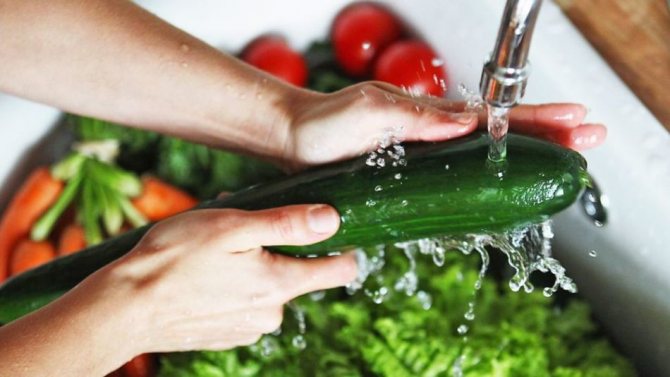
By 5 months we introduce cucumbers
The ideal time when you can introduce cucumbers into your diet is when your baby is 4 or 5 months old. By this time, the child’s problems associated with digestion have disappeared, and therefore the baby begins to react to new ingredients not very sensitively. Do this gradually, in small portions, eat cucumbers only in the morning, so that during the day you can monitor the baby’s reaction.
Remember that cucumber is a healthy ingredient for both mommy and her little one. Hence, don't skip these vegetables. Eat in accordance with the advice of doctors and try to additionally focus on your observations of the child’s sensations and reactions.
Buying the “right” cucumbers: tips for choosing
You need to purchase fresh vegetables only in season, from a trusted manufacturer. Cucumbers grown for mass sale may contain harmful components: chemical fertilizers, remedies for diseases, preservatives for long-term storage.
How to choose a good cucumber:
- Buy fruits of medium size and regular shape. Large ones may be overripe and have a bitter taste. Deformed ones can also taste bitter.
- The color should be uniform.
- A good fruit is firm to the touch and does not form dents when pressed. The pimples on the skin should also be hard.
- Has a characteristic aroma of freshness.
Do not purchase:
- If spots of a dark or light shade are visible on the surface, they are soft when pressed. Such spots indicate the beginning of rotting of the fruit.
- Even if you cut off the rotten area, you cannot get rid of the bacteria that have spread throughout the pulp.
- If the fruits have a specific smell (rot, presence of pesticides).
- With damaged peel: these are places of penetration of bacteria.
- If the cucumbers are wet, they were moistened to restore freshness.
Salted and lightly salted vegetables are purchased at the appropriate sales points. It is not recommended to buy food from sellers at spontaneous markets. Use only homemade pickled cucumbers. Industrially produced marinades should be discarded.
What salad should a nursing mother prepare for breastfeeding?
The diet of a nursing mother involves giving up a number of foods. Immediately after birth, the restrictions are quite strict, but over time the menu expands. The diet includes fresh vegetables and fruits.
They replenish the supply of valuable elements and dietary fiber. Plant foods are combined with meat and fish in hot dishes and salads. Many of them can be eaten while breastfeeding if prepared correctly.
We will look at which recipes are suitable for young mothers in this article.
Despite the seemingly meager list of permitted products, a breastfeeding mother can always “put together” a hearty and interesting salad for every day or holiday
General principles for preparing salads
The rules that mothers should follow when choosing products are given below:
- The first time after childbirth, vegetables and fruits are subjected to heat treatment, they are stewed, boiled, baked, but not fried.
- In the first month of breastfeeding, it is better to avoid salads containing more than two components. The baby's immature intestines react poorly to complex combinations of foods.
- It should be taken into account that red vegetables and fruits are more likely than others to cause negative reactions. For the first two months, it is advisable to prepare dishes from green and yellow vegetables. They are classified as hypoallergenic.
- Greens and leaves are washed with running water. Fruits and vegetables should not have rotten areas, wormholes or other defects. If possible, they are washed with soap. This will reduce the likelihood of intestinal infections and parasites.
- The skin contains insoluble fiber, which often causes digestive problems in infants. It is advisable to clean it off until the baby is 4 months old.
- Vegetables and fruits are chosen according to the season. Preference is given to local species. It is advisable to introduce exotic fruits (except banana) during breastfeeding after 9 months.
The salad is prepared from vegetables grown on your own plot, or you buy farm products. A breastfeeding diet involves avoiding canned food, pickles, and store-bought sauces. Such foods often provoke colic and increased gas formation.
What salads can nursing mothers eat: selection of ingredients
During the first months of breastfeeding, snacks are prepared according to recipes that include:
- boiled meat. It is allowed to eat chicken, turkey, rabbit, lean beef, pork;
- offal. It is useful for a young mother to eat liver and chicken hearts;
- boiled, baked fish. It is best to eat cod, pollock, hake, pike perch in the first months of lactation, then include fatty varieties in the diet - herring, mackerel. Salads with smoked, salted fish, preserves, canned food, and crab sticks should be excluded;
- vegetables. During the first months, salads during breastfeeding are prepared from green and yellow species. It is allowed to add broccoli, zucchini, squash, pumpkin, green peas, green beans, and potatoes to the dish. Then add corn, cucumber, green pepper, yellow tomatoes, lettuce, carrots, beets;
- fruits. A young mother is allowed snacks with an apple, pear, and banana. After 3 months you can add persimmon, pomegranate;
- dairy products. Cheese, feta cheese, yogurt, and kefir are also used in snacks if the baby tolerates them well.
The list of ingredients is extensive. You can make many combinations of everyday and holiday dishes from them.
Salad recipes for nursing mothers
Vegetable snacks will help improve digestion, prevent constipation, and cleanse toxins. Fruit salad will replace dessert for a nursing mother. Cold dishes with the addition of meat and fish are an additional source of protein, useful elements important for the development of the baby.
Vegetable salad
A classic summer dish. To prepare it take:
- cucumbers;
- tomatoes;
- Iceberg leaves;
- parsley;
- dill.
Vegetables are cut into cubes. Leaves are torn by hand. The greens are chopped. All components are mixed. The appetizer is salted to taste and seasoned with sour cream. This dish organically complements lunch and dinner.
Beet salad with dried apricots
Despite the bright color, the root vegetable rarely causes allergies. Experts allow you to include boiled beets in your diet after discharge from the hospital. Especially if you have problems with stool. Beetroot salads are weak, so you need to eat them little by little, no more than 3 times a week.
Walnuts and dried apricots often cause bloating in babies, so the proposed dish can be eaten from 3-4 months of lactation.
List of ingredients:
- 2 beets;
- a tablespoon of chopped walnuts;
- 50 g hard cheese;
- dried apricots - 3 pieces;
The root vegetable is boiled in salted water. Dried apricots are ground in a blender or food processor. It is advisable to soak the nuts. This will help avoid heaviness and discomfort of the gastrointestinal tract. The nuts are infused for 8 hours in salted hot water. Glassware works best. The ratio of liquid to nuts should be 2:1. The soaked product is dried and crushed.
Beets and cheese are cut into cubes. Add dried apricots and walnuts, season with oil.
Salads with beets are an excellent remedy for mothers in the fight against postpartum constipation.
Caesar salad for a nursing mother
To make the dish fit into the diet, the composition of the sauce is slightly changed. The main ingredients remain the same:
- chicken breast;
- a bunch of lettuce;
- 70 g Parmesan cheese;
- Cherry tomatoes;
- wheat flour loaf;
- olive oil;
- lemon juice.
The meat is dipped into boiling water. To make the breast soft, cook it over high heat for half an hour. Half is enough for three servings. The rest of the pulp can be used to make soup or soufflé.
While the breast is cooking, prepare the crackers. To do this, 1/4 of the loaf is cut into small cubes. They are laid out on a sheet of baking paper in one layer. In an oven preheated to 100 degrees, the sliced loaf is dried until golden brown.
Caesar is prepared in a wide dish. The bottom and sides of the dish are covered with lettuce. They tear it with their hands. Chicken fillet is cut into large cubes and placed on leaves. The meat is sprinkled with crackers. Each tomato is divided into quarters. The cheese is crushed with a coarse grater.
The ingredients are mixed immediately before eating after adding lemon juice and olive oil. "Caesar" is allowed from the 3rd month of lactation. If you remove lemon juice from the recipe, the tomato dish can be prepared when the baby is one month old. Caesar fills you up well. It is perfect as a snack and complements a holiday dinner.
Caesar salad is one of the easiest to prepare dietary salads for a nursing mother.
Salad with cottage cheese and vegetables
This dish is introduced in the third month of lactation, if the baby responds well to fresh vegetables and fermented milk products.
List of components:
- 100 g of granular cottage cheese, fat content no more than 5%;
- yellow tomatoes;
- bell pepper;
- green onions.
Vegetables are cut into cubes. Finely chop the onion. Vegetables are mixed with herbs and cottage cheese.
Greek salad while breastfeeding
Nutritionists do not recommend using the classic version for up to six months. Olives are a canned product. Peppers, according to nutritionists, are difficult to digest. If a woman tolerates these products well, the baby will most likely not have any bad reactions.
Ingredients:
- Green pepper;
- cucumber;
- Cherry tomatoes;
- Feta cheese 150 g;
- olives;
Vegetables are peeled. Tomatoes are cut into quarters, cucumbers and peppers into half rings, cheese into cubes. The salad is dressed with olive oil and salted to taste. The dish goes well with parsley and dill.
Salad with zucchini and cream cheese
Included in the menu from the third month of feeding. List of components:
- half a young zucchini;
- a bunch of iceberg lettuce;
- 100 g curd cheese;
- 80 g Parmesan;
- 3 tablespoons of sunflower (corn) oil;
- kiwi.
Parmesan and zucchini are grated with a grater. Remove the skin from the kiwi and cut it into slices. Lettuce leaves are crushed by hand. Mix all ingredients and add a spoonful of soy sauce.
Meat salad with apples
For snacks, choose green or yellow fruits.
List of components:
- 2 apples;
- one chicken fillet;
- a bunch of lettuce;
- lemon juice;
- vegetable oil.
The meat is boiled. Apples are cut into cubes. All components are combined in a high plate.
Fish salad (similar to Mimosa, adapted for nursing women)
To prepare this option, take:
- 300 g cod;
- 4 eggs;
- 2 large carrots;
- potatoes - 5 pieces;
- green onions;
- homemade mayonnaise.
It is laid out in layers in a wide dish. Vegetables, eggs, fish are boiled. Cod can be replaced with another low-fat type. The fillet is separated from the bones, cut into small pieces, mixed with chopped onion. Vegetables and eggs are crushed with a grater. Sequence of layers: fish with onions, potatoes, carrots, white, yolk. Each of them is soaked in homemade mayonnaise.
Mimosa salad is a classic fish salad that can be adapted for use while breastfeeding.
Sweet salad
This dish is suitable for second breakfast or dessert.
Grocery list:
- green apple (“Golden”, “Simirenko”);
- sweet tomato;
- banana;
- grated hard cheese;
- 2 eggs;
- yogurt.
Tomato and fruit are cut into small cubes. Eggs and cheese are crushed with a grater. The products are mixed and topped with yogurt without fillers.
Salad "Tatar"
This dish can be eaten from the second week of breastfeeding. The salad is very filling and healthy, especially for women with low hemoglobin.
Ingredients:
- 200 g beef liver;
- carrots – 3 pieces;
- onion head;
- parsley;
- low-fat sour cream.
The liver is cut into strips, salted, and stewed in a small amount of water along with chopped onions for 20-30 minutes. Boil carrots until soft, cut into strips. The ingredients are mixed, seasoned with a small amount of sour cream.
The vinaigrette
The classic recipe for the dish includes sauerkraut, pickled cucumbers, and fresh onions. These products often cause fermentation and discomfort in the baby.
It’s easy to prepare a healthy analogue of vinaigrette for a nursing mother - just exclude controversial ingredients from the composition, such as peas, cabbage, and pickles.
Ingredients of the vinaigrette for gw:
- boiled beets, carrots, potatoes;
- green pea;
- dill;
- salt;
- unrefined vegetable oil.
Boil vegetables and cut into cubes. The peas are stewed until soft. The products are combined, salted, seasoned with oil and herbs. When the baby is three months old, you can add some pickled cucumbers from home supplies to the vinaigrette.
Chinese salad
This dish is prepared without hot spices. The advantage of the salad is that the ingredients can be found at any time of the year.
Grocery list:
- 300 g chicken fillet;
- Chinese cabbage - several leaves;
- carrots – 2 pieces;
- green peas – 100 g;
- cauliflower – 150 g;
- dill seed;
- parsley;
- soy sauce.
The meat is boiled, chopped, and seasoned with soy sauce. Vegetables and peas are boiled in water with the addition of dill seeds and salt. Cauliflower is separated into inflorescences. Carrots are cut into strips. The ingredients are mixed. Hand-chopped Chinese cabbage, parsley, and vegetable oil are added to them.
There are many options for preparing Chinese salad. Among them you can easily find one that is healthy and safe for a breastfeeding woman.
